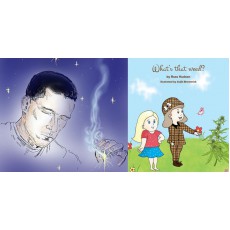
A children’s book about weed sounds like something an anti-weed crusader would worry about. But, while the marijuana industry enriches more people but remains legally obscure, how families discuss the industry with their children is a tricky topic. The new children’s book “What’s That Weed” aims to start that conversation.
Russ Hudson found the illicit marijuana industry at a young age. “I was a street kid, orphaned when I was young and bounced around in state custody,” Hudson says. He turned to cannabis for all the same reasons anyone does, plus, as a poor orphan, selling weed was an easy way to keep money in his pocket.
Hudson latched on to the cannabis industry. First as a weed dealer, but he saw the tide turning and made steps in 2007 to gain his footing in the legal market. The illegal trade had lifted him out of poverty, and the legal industry started taking him all over the world.
Hudson moved to the Netherlands, and then a little while later Barcelona. He would consult different clients on growing, and other aspects of the cannabis plant and product.
In between the moves, and solidifying his place in the new and exploding industry, Hudson started a family with his wife, Rachel. His daughter, who is now six, lives in a household where there’s no stigma around cannabis. The Hudson’s live mostly off the grid and use marijuana for many different things around the house. Leaves for salad, seeds for their chickens, even making their own oil.
“What’s That Weed” is Hudson’s way of showing that cannabis is totally normal. Hudson hopes that this book can help other parents in the marijuana industry explain the product to their kids too.

Hudson’s life isn’t typical of most parents. Most people generally don’t work with illegal plants, so explaining what he does to his daughter was difficult. “So much of my life revolves around cannabis,” he says, “no matter how much it seems normal, it’s not normal.”
Hudson’s daughter though understands what her dad does. But in long conversations with her, Hudson realized that a children’s book could help answer many of the questions curious kids have. “I wanted to write this book for my daughter, and I think there are a lot of parents out there who would like to have this discussion and stop hiding.”
Before his daughter was born, Hudson had decided that he was going to totally upfront about his affiliations with cannabis. Many parents, even those in the industry don’t, but he understands why. “A lot of people are scared shitless,” he says. Their fear isn’t unfounded. Child Protective Services in the United States has targeted medical marijuana users. There’s no reason to assume those inside the industry will be safe.
The story focuses on two little girls. One notices a strange plant on her friends family farm, and the book follows her learning journey.
Most of the book deals with many uses of cannabis. It doesn’t focus on the recreational side of things much at all. But, that hasn’t stopped some readers from taking issue with one scene from the book. It outlines the practical uses of the plant, as well as medicinal benefits. Only briefly does it touch on the recreational side of things, and that’s already drummed up a little controversy.
“There’s been a little negative chatter, mostly about the scene where the father is smoking in front of the two little girls.” The scene portrays the girl’s father smoking a pipe and reading a book. It’s the only mention of recreational use in the story. Other characters use marijuana, but to treat epilepsy and PTSD.
Hudson thinks weed must be normalized. That’s why he’s taking “What’s That Weed” on a library tour.
The plan for the tour is to share the book with as many people as possible, and also gain an understanding of the public at large will perceive it. “I’m excited and a little anxious to see what the perception will be,” he says.
Part of the goal for the book is to help bring cannabis and hemp back to American life the way it was before prohibition started. Hudson lives on a farm, and points out, “the plant has a tone of uses on any farm.”
The ultimate goal for Hudson is a rare one among writers. “I hope in 20 years, my daughter wonders why I had to write this book,” he says.
